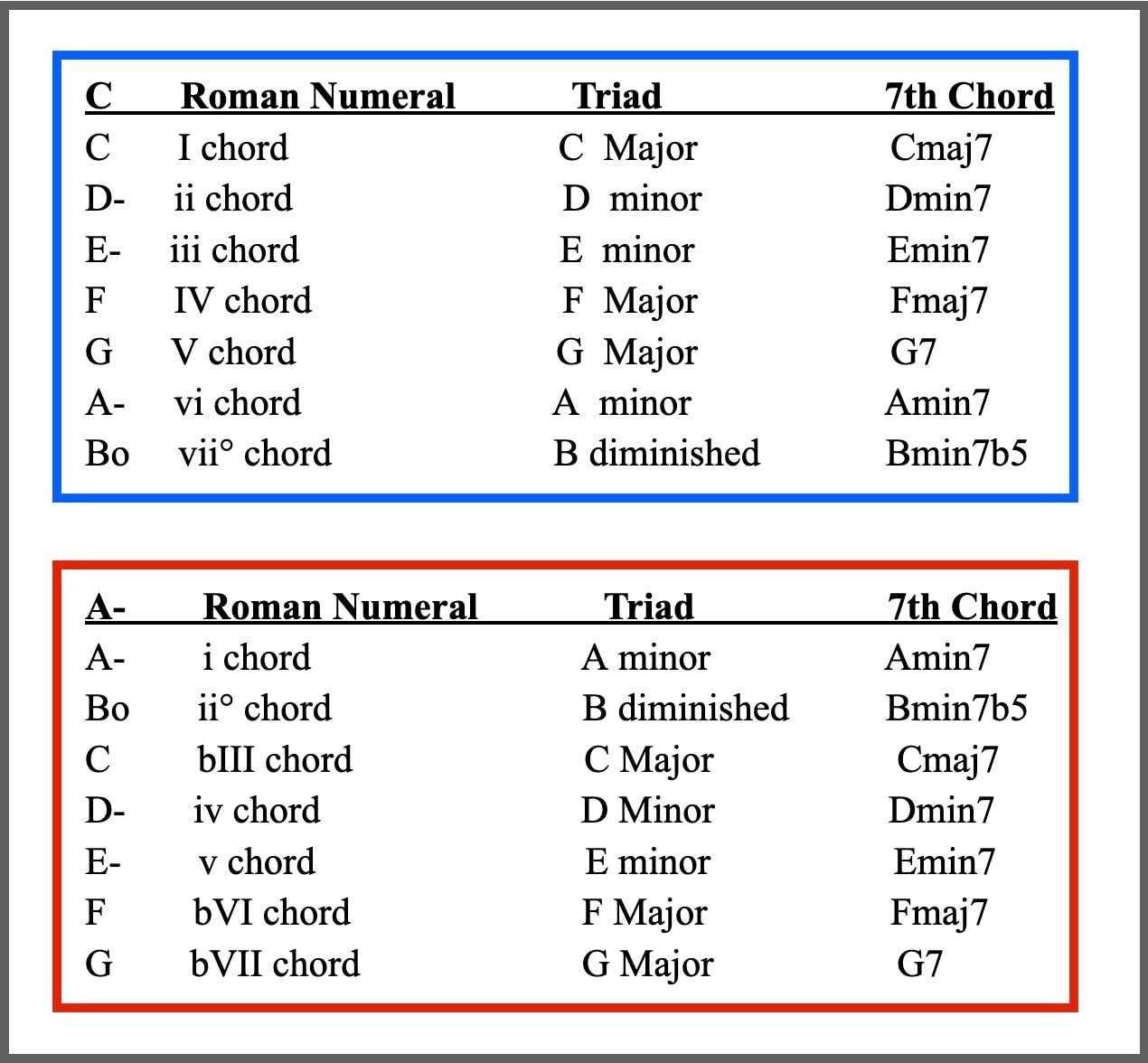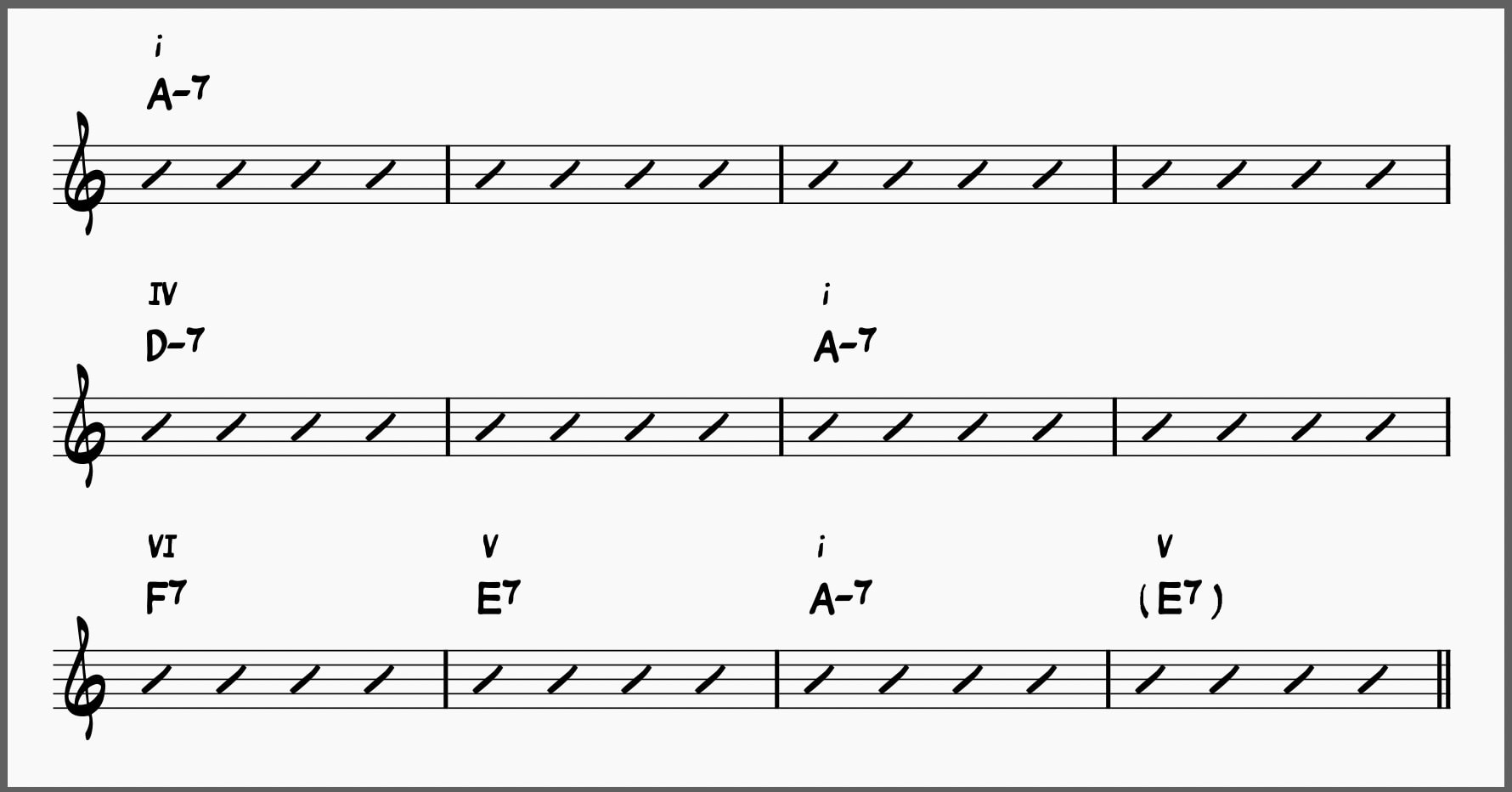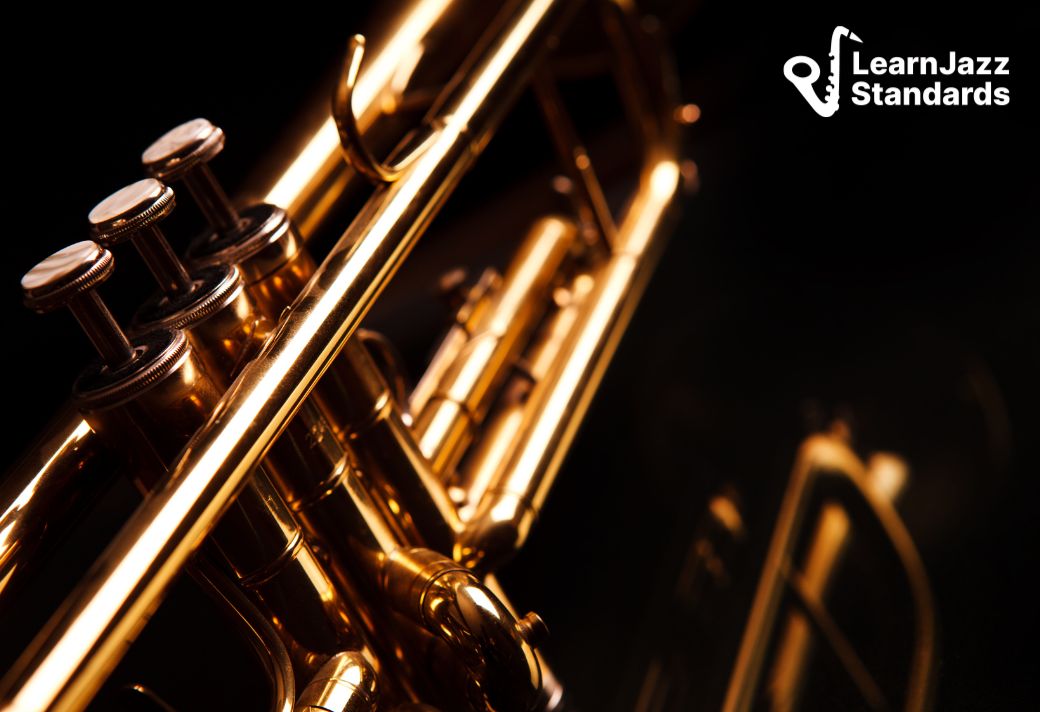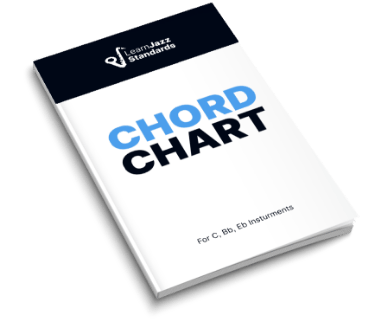To master jazz, you must play through and memorize common minor chord progressions! From a short minor iiø-V-i to longer tunes written entirely in minor keys, minor chord progressions comprise about twenty-five percent of all jazz standards.
In this article, we’ll discuss all the minor chord progressions you’ll likely encounter in jazz standards! This thorough deep dive will leave you primed to tackle jazz standards in minor keys and effectively navigate minor chord progressions embedded in tune written in major keys.
After a brief chord review, we’ll discuss what makes a minor chord progression minor, learn many common minor chord progressions, and go over the best ways to practice common minor chord progressions.
All this information will be invaluable if you want to create chord progressions on your own!
If you love learning jazz and want to take your jazz playing to the next level, check out the Learn Jazz Standards Inner Circle. The Inner Circle has everything you need to seriously upgrade your jazz chops.
Improve in 30 Days or Less. Join The Inner Circle.
Let’s dig in.
Table of Contents
Music Theory Chord Review
Before getting into minor chord progressions, we should ask, “Where do chords come from?” In Western music, chords are three or more notes played simultaneously. These notes come from scales. This might be a review for some readers, but it never hurts to refresh your memory!
However, if your chord theory is solid, skip to the next section.
Here are the notes in a C major scale:

Learn more about the major scale here.
- C-D-E-F-G-A-B-C
Here is the same scale harmonized in thirds.

Look at the first note, C. We’ve placed a note a 3rd above it. This is an E. Then, we’ve put a third above that. This is a G. The notes we’ve placed above C aren’t arbitrary. They come from other scale degrees in the major scale.
When you do this with every note, you end up with all the diatonic chords in the key of C major. There are many combinations of chord progressions you can play with these seven chords alone.
- I chord: C
- ii chord: D-
- iii chord: E-
- IV chord: F
- V chord: G
- vi chord: A-
- vii° chord: B°
Let’s go through the same process on the natural minor scale.
The notes in an A natural minor scale are:

Learn more about the Aeolian scale (natural minor scale) here.
- A-B-C-D-E-F-G-A
When we harmonize the natural minor scale by stacking thirds, we end up with all the diatonic chords in the minor key.

One thing you’ll notice is that the key of C major and the key of A minor share the same chords. We simply changed what we were counting as the i chord. Instead of a C (I chord), we now have an A- (i chord).
- i chord: A-
- ii° chord: B°
- bIII chord: C
- iv chord: D-
- v chord: E-
- bVI chord: F
- bVII chord: G
That’s because C major and A minor are relative major and minor keys, so they share the same key signature (and the same notes as a result). Parallel minor keys share the same root note, and relative keys share the same key signature.

We have a major key and its relative minor key. And they each share the same chords! So, what would make a chord progression major or minor if the chords from both keys are all the same?
It depends on how they resolve!
Minor key chord progressions resolve to a minor chord, and major key chord progressions resolve to a major chord. But let’s get more specific! It turns out that musicians could mean one of two things when using the phrase “chord progression.”
Check out this article for more information on diatonic chords and this one to learn more about relative and parallel keys.
Defining “Chord Progression”
Again, defining something that seems so apparent might seem like a pointless exercise, but it matters. There are two ways to think about chord progressions.
- The entire chord sequence of a composition, as in the chord progression of “Misty.” In this case, I am referring to the whole form of the tune.
- A shorter sequence of chords within a composition, as in the I-VI-ii-V turnaround at the end of “Misty.” These are the chord progression building blocks that make up the whole song.
The takeaway is that musicians use the term chord progression to refer to both the parts within a chord progression and the chord progression as a whole.
Check out this article to learn more about the “Misty” chord progression.
So, What About Minor Chord Progressions?
Considering our dual definition, a minor chord progression can mean two things.
- A composition written entirely or primarily in a minor key, like the tune “Beautiful Love.”
- A shorter sequence of chords that resolves minor and mainly uses chords built from minor scales (natural minor scale, melodic minor scale, or harmonic minor scale).
Let’s see what chords we can build from the different minor scales, as they will be essential for understanding minor key songs.
Natural Minor Scale Chords
We’ve already seen what kind of triads we can build from the natural minor scale, but let’s explore the 7th chords we can construct. To make 7th chords, we add another third to each chord in the series. This gives us the diatonic series of 7th chords!

- i chord: A-7
- iiø chord: Bø
- bIII chord: Cmaj7
- iv chord: D-7
- v chord: E-7
- bVI chord: Fmaj7
- bVII chord: G7
Check out this article to explore 7th chords further.
Melodic Minor Scale Chords
Minor scale chord progressions may also use chords derived from the melodic minor scale, which has a major sixth scale degree and a major seventh scale degree. By comparison, the natural minor scale has minor sixth and seventh scale degrees.
That means you’d spell the A melodic minor scale like so. I’ve bolded the notes that distinguish it from the natural minor scale.
- A-B-C-D-E-F#–G#-A
Here is melodic minor harmonized as seventh chords:

- i(maj7) chord: A-(maj7)
- ii chord: B-7
- bIII(#5) chord: Cmaj7
- IV chord: D7
- V chord: E7
- viø chord: F#ø
- viiø chord: G#ø
There are unique-sounding, non-diatonic seventh chords in this scale.
- The i (maj7) chord is a minor triad with a major 7th.
- The bIII#5 chord is an augmented chord with a major 7th.
Check out this article for more on the melodic minor scale.
Harmonic Minor Scale Chords
The chords derived from the harmonic and melodic minor scales are quite similar. However, these scales differ by one note—the 6th scale degree. Instead of a major 6th and 7th, the harmonic minor scale has a minor 6th and a major 7th, giving it a unique minor third gap between the 6th and 7th notes.
- A-B-C-D-E-F-G#-A
To see what chords are derived from the harmonic minor scale, you can take the melodic minor chords from the last example and change all F sharps to F naturals. Here is what you get.

- i(maj7) chord: A-(maj7)
- iiø chord: Bø
- bIII(#5) chord: Cmaj7
- iv chord: D-7
- V chord: E7
- VI chord: Fmaj7
- vii° chord: G#°7
There are also unique-sounding, non-diatonic seventh chords in this scale.
- The i(maj7) chord is a minor triad with a major 7th.
- The bIII#5 chord is an augmented chord with a major 7th.
- The vii chord is a fully diminished chord
Check out this article for more on the harmonic minor scale and this article for more on the three types of minor scales.
Minor Chord Progressions Have Much More Chord Variety Than Major Chord Progressions
When you go to create minor chord progressions, you have three different sounding scales from which to choose chords. For example, many minor chord progressions will have a dominant V chord, even though the natural minor scale has a minor v chord.
This is because the composer borrows that chord from either the melodic or harmonic minor scale, both of which have a dominant V chord. This process is known as modal interchange or using “borrowed chords.”
Borrowed chords are common in major and minor compositions, but they sound more natural and don’t stand out as much in minor chord progressions because we are more used to hearing them.
And it makes sense why.
It just sounds better to have a dominant V chord resolve to a i chord because the leading tone (major 7th or G# in our case) has a stronger pull back to the tonic (root or A) than the subtonic (minor 7th or G) has. A V-i cadence is stronger than a v-i cadence.

Learn more about musical cadences.
In other words, the diatonic v chord in minor keys has a subtonic resolution to the tonic (G to A), which isn’t as strong as the borrowed V chord, which has a leading tone resolution to the tonic (G# to A).
Check out these articles to learn more about chord substitutions and borrowed chords.
BEFORE YOU CONTINUE...
If music theory has always seemed confusing to you and you wish someone would make it feel simple, our free guide will help you unlock jazz theory secrets.

Common Minor Chord Progressions
We’re finally ready to cover common minor chord progressions you will likely encounter in jazz standards! If you become familiar with these, you’ll know exactly what to do when encountering them.
For this article, I’ll focus on our second definition of minor chord progressions: A shorter sequence of chords within a composition that resolves to a minor chord.
We aren’t focusing on the minor chord progressions of entire songs. Instead, we will focus on the chord progression building blocks that make up a whole tune.
Also, note that all of the dominant V chords can be altered! I won’t write alterations into the progressions, but V chords in minor chord progressions are often altered with the following alterations
- b9
- #9
- #11/b5
- #5/b13
Let’s start with our first progression—this one has no dominant V chord!
1. Diatonic iiø-v-i
This is the diatonic version of the minor ii-v-i. Here, the v chord (an E minor chord) is a min7 chord, not a dominant one. It is less common than the previous example in jazz music, but it does occur. You’ll likely find this minor progression in popular music, which trends toward diatonic tonalities.

2. iiø-V-i
This is the classic minor version of the most important chord progression in all jazz! Like its major counterpart, minor iiø-V-i chord progressions are the backbone of many minor progressions.

This classic minor ii-V borrows the dominant chord from one of the non-diatonic minor scales. However, any chord can be swapped from one of the three minor scales, giving you a lot of variety. Below are minor ii-V-i progressions pulled from the melodic minor and harmonic minor scales.
You’ll definitely see these progressions in many minor jazz tunes.
2.1 ii-V-i(maj7) or Melodic Minor ii-V

2.2 iiø-V-i(maj7) or Harmonic Minor iiø-V

As you can see, we have so many options when building minor chord progressions—even the simple minor ii-V-i! I also want to note that people don’t refer to these variations as the “harmonic minor iiø-V” or the “melodic minor ii-V.” They are all referred to as minor ii-Vs.
But I want to explain where all these variations come from thoroughly!
3. Deceptive ii-V-i
The deceptive ii-V-i cadence starts with a major ii-V to the tonic chord, which resolves to an A minor but feels like it will resolve to A major (hence the deception). This ii-V is the opposite of the deceptive iiø-V, which wants to resolve minor but resolves major!

Check out this article to learn more about the ii-V-I progression.
4. Diatonic i-bVI-iiø-v-i
The diatonic minor i-bVI-ii-v chord progression is less common in jazz music. Still, it is nonetheless one of the more popular chord progressions for minor pop tunes or classical music. I decided to include it here for thoroughness.

It’s much more common in jazz to play a dominant V chord rather than a diatonic v chord, so here is a i-bVI-iiø-V-i progression as you’d encounter it in many jazz tunes.
5. i-bVI-iiø-V-i

6. iiiø-VI-iiø-V-i(maj7)
This minor chord progression is comprised of a series of two chord progressions—two minor iiø-Vs that resolve to a minor chord. The iii chord starts on the major third scale degree of the tonic chord, so a C# in our case, despite the minor third present in the tonic chord.
Starting from the major third of the tonic chord allows us to have a smooth sequence where the first iiø-V leads directly to the second before resolving to our tonic chord.

7. Deceptive iii-VI (or vi)-ii-V-i
Like our deceptive ii-V from above, we’d expect this progression to resolve to the parallel major key of A major. Instead, we resolve to A minor.

8. i–bVII–bVI–V or the Andalusian Cadence
This is one of the oldest minor chord progressions on this list! It dates back to the Renaissance period and is one of classical music’s most popular chord progressions. It also is used in popular music and jazz (though less frequently in jazz).

Learn more about the Andalusian Cadence here.
9. i–bVII–bVI–bVII–i
This progression is similar to the Andalusian cadence above but never moves to the V chord. Instead, it moves back up to the bVII before resolving to the i chord.

10. i-bVI-bIII-bVII
This is another common minor chord progression that is more common in popular and classical music but still occurs in jazz.

11. Wandering 7th Chord Progression
This progression is a bit different than the rest because it is more about the movement of a single voice within a harmonic structure than a traditional “progression.” However, it occurs frequently in minor jazz tunes.
This progression starts with an A- triad, which becomes an A-(maj7) as the root moves down a half step. That voice keeps moving down in half steps to make an A-7, then an A-6, then a Fmaj7/A (or A-(b6)), before moving down to one final half step to E, where we change the chord to an E7.

I’ve colored the wandering voice in green. Notice how it descends stepwise from the root till it reaches the fifth.
12. Minor Blues Progression
The blues form is so standardized that including the entire minor blues form makes sense. A simple major blues has only three chords in its harmonic progression—I, IV, and V. However, a minor blues will add a VI chord in the first measure of the last four bars, making the final progression VI-V-i-V.
Here are the last four bars or the “turnaround” of a major simple blues in the relative major key of C. Check out this article to learn more about jazz turnarounds.

Compare that to the turnaround of a minor blues in the relative minor key of A minor. Note the VI chord added into the mix.

Here is the complete minor blues form.

Check out this article on blues progressions and this one on 9 jazz chord progressions for more information on all the different types of chord progressions!
How to Practice and Master Minor Chord Progressions
We’ve gone through many crucial minor chord progressions you need to know to play jazz effectively. But how do you practice them? Here are five tips!
12 Key Common Chord Progressions
It goes without saying that 12 keying licks, melodies, and chord progressions is the best way to internalize musical ideas and execute them on your instrument, no matter the situation. Try taking one of the progressions from this list and moving it through the cycle of fourths.
Try moving these progressions by other intervals, like descending minor thirds or ascending whole steps. Doing this will help you internalize the progression and get comfortable moving major and minor chords around in different contexts.
Be Sure To Practice In Time
Time feel is perhaps the most important and most challenging skill to develop for any musician. That’s why practicing in time with different grooves is so vital for developing musicians.
Always use a metronome or a backing track to ensure your changes are smooth and in time. It doesn’t matter how slow you play it as long as it’s in time!
Identify Common Chord Progressions As You Discover Them in Jazz Standards
Jazz harmony is built on a foundation of recognizable progressions, so as you learn new tunes, take note of the many recurring harmonic patterns.
Recognizing a minor iiø-V-i in a song like “Autumn Leaves” or a wandering 7th progression in “Softly, as in a Morning Sunrise” will make you a stronger musician. The more you see these patterns, the faster you can apply them in different contexts.
Practice Chord Progression Ear Training
Hearing minor chord progressions is just as important as playing them! Try singing the movement of different voices in the progression. Also, try identifying common minor progressions by ear.
Listening to recordings and transcribing progressions will strengthen your ability to recognize them in real time!
Write Your Own Minor Chord Progressions
Composing your own minor progressions is a great way to internalize them! Experiment with different minor tonalities, chord substitutions, and passing chords to create harmonic interest and movement.
Composition is like improvising without the constraint of a steady beat! It allows you to get creative and try things you might not be able to do under the pressure of a metronome.
Writing progressions will deepen your understanding of jazz harmony and improve your ability to craft compelling chord changes in your improvisation and composition.
The takeaway is to write minor chord progressions!
Take Your Jazz Chops To The Next Level—Join The Inner Circle!
Want to take your jazz playing to the next level? Check out the Learn Jazz Standards Inner Circle. The Inner Circle helps you cut out all the noise and focus on the tasks that make you a stronger musician.
Improve in 30 Days or Less. Join The Inner Circle.









